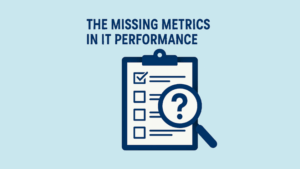Essential CIO Tools: The Business Presentation

This article is the third in a four-part series on the core presentations every CIO or senior IT leader must master.
Previously, we explored:
- The Vision Presentation – which positions you as a forward-thinking executive with a unique point of view on how technology will shape your industry and company.
- The Strategy Presentation – which demonstrates that your IT organization is architected to deliver value in alignment with the enterprise’s operating model.
Today we turn to the Business Presentation—the presentation that’s closest to the day-to-day realities of IT leadership, and often the most underappreciated tool of influence.
What Is the Business Presentation?
The Business Presentation is your comprehensive, transparent, and operationally grounded overview of how IT services are being consumed across the enterprise. It provides business stakeholders with a structured, digestible view of:
- Service delivery volumes and trends
- Application and user activity
- Helpdesk interactions, tiered support metrics
- Infrastructure utilization and uptime
- Project status summaries and associated risks
- Allocated costs by department, function, or initiative
Its purpose isn’t to dazzle—it’s to inform with clarity, foster trust, and shift the conversation from technical details to value delivery.
Why It Matters More Than You Think
While vision and strategy presentations often take the spotlight, the business presentation is where credibility is earned. It shows whether you actually run IT like a business.
Done well, this presentation proves:
- You have a command of IT operations
- You understand cost, demand, and capacity
- You hold yourself accountable to service quality
- You engage the business in a data-informed partnership
It’s especially powerful because it elevates the CIO from reactive firefighter to proactive steward of enterprise resources.
In fact, some of the most influential IT leaders aren’t necessarily the most visionary or the most strategic—but they excel at the business presentation. They can speak fluently in operational metrics, financial impact, and service expectations—and they do so confidently in every meeting.
That earns respect from CFOs, COOs, and CEOs alike.
What It Should Include
The business presentation should be automated, current, and always accessible—especially for quarterly business reviews, annual planning sessions, and regular stakeholder check-ins.
At minimum, it should:
- Reflect trends over time, not just snapshots
- Tie service consumption to organizational units and initiatives
- Include performance indicators and SLA adherence
- Make visible the resource tradeoffs and consumption patterns
- Support real business dialogue—where IT is seen as accountable and transparent
It doesn’t have to be fancy. It just has to be consistent, accurate, and actionable.
The Visibility Paradox
Many IT organizations hesitate to share internal performance and consumption data—often out of concern that the numbers “aren’t good enough.”
But here’s the truth: the numbers don’t improve until they’re visible.
Transparency drives engagement. It invites honest conversations about tradeoffs, demand patterns, and areas for improvement. It fosters partnership. And most importantly, it sends a strong signal that IT is mature enough to own both its wins and its challenges.
You cannot build influence in the dark. Visibility is the cost of entry for strategic relevance.
The Influence Shift
When you lead with metrics and transparency, your meetings shift
from:
- “Why isn’t this project done?”
- “Why did my team have this delay?”
- “Why is IT so expensive?”
to:
- “How can we better manage shared capacity?”
- “What support models are sustainable for our teams?”
- “How do we prioritize investments based on actual consumption?”
That’s when you’re no longer just reacting to complaints, you’re driving business decisions. You’re seen not just as a service provider, but as a peer in resource stewardship.
Final Thought
The Business Presentation isn’t about making IT look perfect. It’s about showing the business that you know what’s happening, you own it, and you’re managing it with rigor.
It tells the story that IT isn’t just supporting the business—it is the business.
And if you want a seat at the table, this is the presentation that earns it—again and again.
Even if the numbers aren’t where you want them to be, sharing them earns you credibility. With time and trust, it earns you influence.Coming next: How to integrate the Vision, Strategy, and Business presentations into a powerful, adaptable narrative that supports any executive conversation—and drives your influence agenda.


